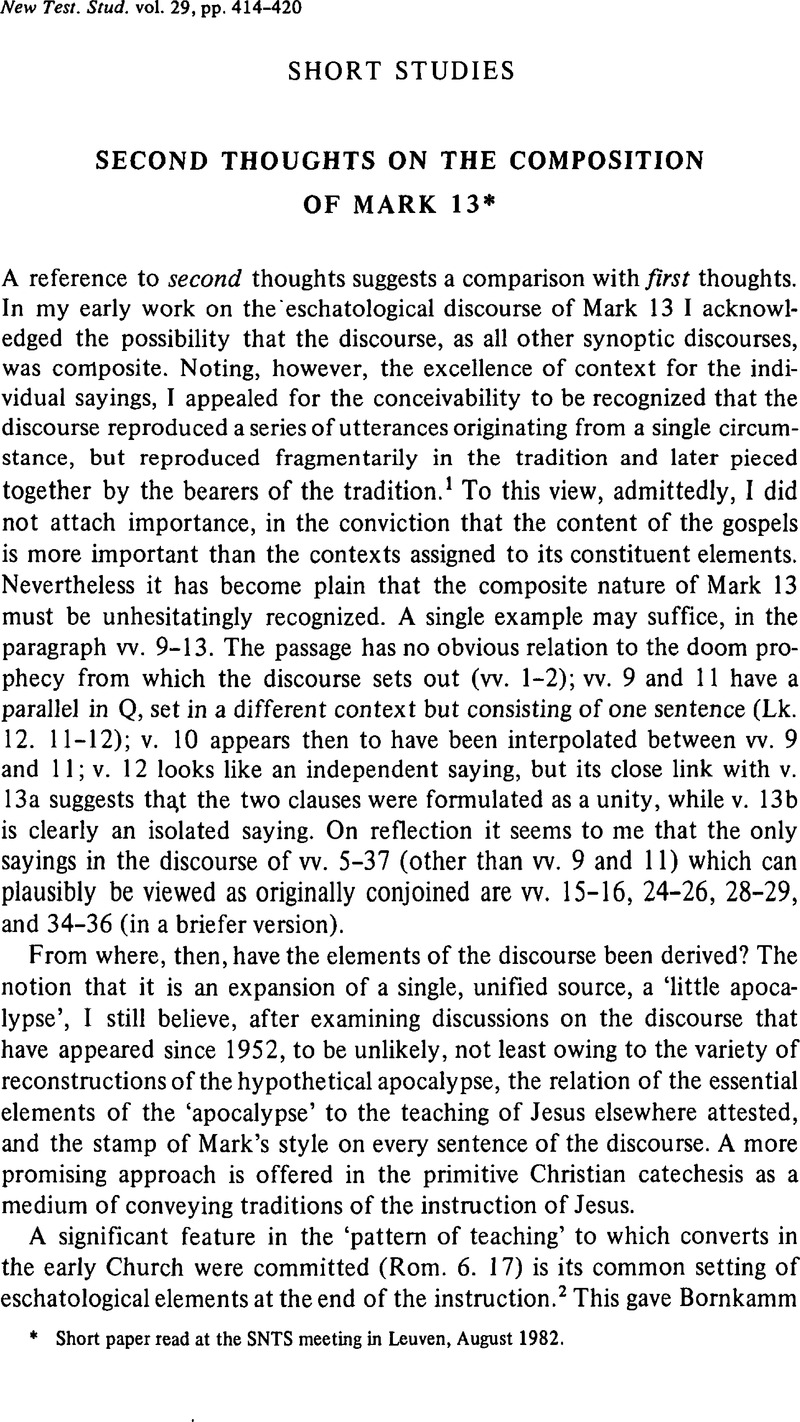Published online by Cambridge University Press: 05 February 2009

[1] See Jesus and the Future, An Examination of the Criticism of the Eschatological Discourse, Mark 13, with Special Reference to the Little Apocalypse Theory (London, 1954), pp. 207–12.Google Scholar
[2] So e.g. Dodd, C. H., ‘The “Primitive Catechism” and the Sayings of Jesus’, in New Testament Essays: Studies in Memory of T. W. Manson (Manchester, 1959)Google Scholar, reprinted and revised in Dodd, C. H., More New Testament Studies (Manchester, 1968), pp. 12–13.Google Scholar
[3] G. Bornkamm, ‘Die Vorgeschichte des sogenannten zweiten Korintherbriefes’, reprinted in Geschichte und Glaube, 2te Teil, Gesammelte Aufsätze Band IV, pp. 162–94, reproduced in abbreviated form in ‘The History of the Origin of the Socalled Second Letter to the Corinthians’, NTS 8 (1962), pp. 258–64.CrossRefGoogle Scholar
[4] ‘Zum Verhältnis von Christologie und Eschatologie im Markusevangelium’, in Festschrift H. Conzelmann, Jesus Christus in Historie und Theologie (1975), pp. 396–8.Google Scholar
[5] Cf. Grayston, K.: ‘By these means the crucifixion is seen in its full eschatological significance; and at the same time the eschatological expectations of the Church are controlled by the crucifixion’, ‘The Study of Mark XIII’, BJRL 56 (1974), p. 387.Google Scholar
[6] Cf. e.g. 1 Thess. 5. 3; 2 Thess. 2. 2–12; 1 Tim. 4. 1–3; 2 Pt. 3. 3–4; and the developments of the theme in Revelation 13,16,17.
[7] 1 Thess 1. 6, 3.1–4; 2 Thess. 1. 4–7; 1 Pt. 3. 13–17, 4. 12–19; Jas 1. 12.
[8] 1 Thess. 5.1–11; 2 Thess. 1. 5; 1 Pt. 1.13,4. 7,5. 8.
[9] 1 Thess. 2. 16; Mk. 13. 14 finds a clear echo in 2 Thess. 2. 4; and cf. the implications of Romans 9–11, e.g. in Rom. 9. 22–23, 27–28.
[10] For warnings against false messiahs and prophets cf. Mt. 24. 26–7 = Lk. 17. 23–24; persecutions and sufferings of God's people, Mt. 5. 11–12 = Lk. 6. 22–23; Mt. 10. 23; Mt. 10. 24–25 = Lk. 6. 40; Mt. 10. 28 = Lk. 12. 4–5; Mt. 10. 32–33 = Lk. 12. 8–9; Mt. 10. 34–36 = Lk. 12. 51–53; the call to watchfulness in light of the incalculable parousia, Mt. 24. 37–41 = Lk. 17.26–30,34–36; Mt. 24. 43–44 = Lk. 12. 39–40; Mt. 12. 45–51 = Lk. 12. 42–46.
[11] For Bultmann it is a biographical apophthegm, History of the Synoptic Tradition (Oxford, 1968), pp. 36, 60Google Scholar; V. Taylor views it as a pronouncement story, The Gospel according to Mark (London, 1959), p. 500.Google Scholar
[12] See the discussion of L. Hartman, Prophecy Interpreted (Lund, 1966), pp. 211–12.Google Scholar
[13] See e.g. 1 Thess. 5. 6–8; 1 Pt. 4. 7,5. 8–11; Rom. 13.11–13; Eph. 6.10–18.
[14] ‘Little in this address… bears the marks of authenticity. Not even verses like 30 and 32 possess the characteristics of faithfully delivered words of Jesus… So much has become plain: in our modern concern for historical truth no norms can be set for the freedom in which Mark took up his task as author’, Die Redaktion der Markus-Apokafypse (Rome, 1967), p. 259.Google Scholar
[15] Das Markusevangelium, Freiburg etc., II. Teil 1977, p. 267.
[16] The linguists accordingly have tended to minimise the influence of Mark's sources upon his gospel; see e.g. C. H. Turner in his articles on Markan Usage in the JTS xxv–xxix (1924–8); Zerwick, M., Untersuchungen zum Markus-Stil (Rom, 1937) (observations are scattered throughout this work, e.g. on p p. 42, 73)Google Scholar; Turner, N., A Grammar of New Testament Greek, IV, Style (Edinburgh, 1976), p. 11Google Scholar; Neirynck, F., Duality in Mark (Louvain, 1972), pp. 14–72.Google Scholar